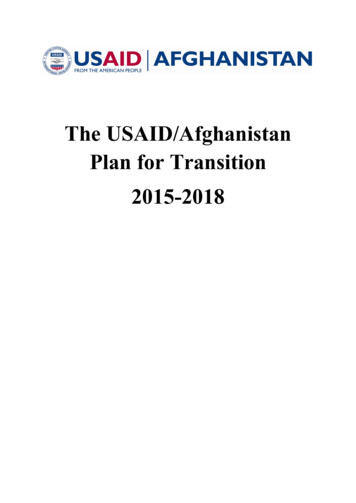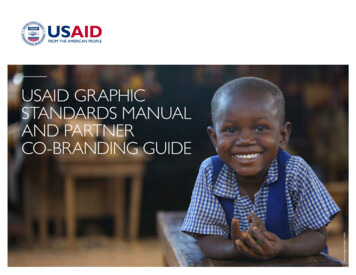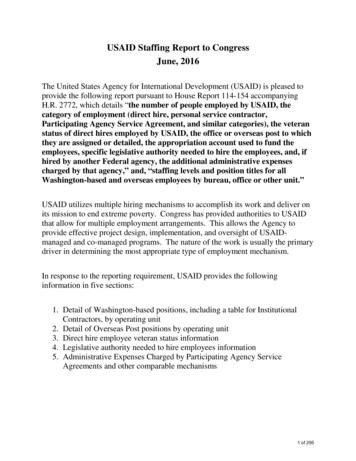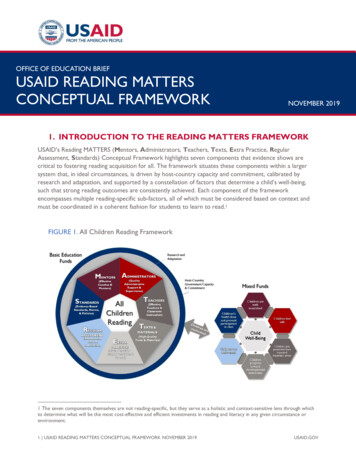
Transcription
The USAID/AfghanistanPlan for Transition2015-2018
USAID/Afghanistan Plan for Transition 2015-2018Date of last revision: August 2, 20162
USAID/Afghanistan Plan for Transition 2015-20181. USAID/Afghanistan’s 2015 Plan for Transition1.1.Development ObjectivesUSAID/Afghanistan’s 2015 plan for transition is based on the premise that private sector-ledeconomic growth will become the main source of increases in government revenue to replacedonor assistance and provide resources for quality service delivery. Sustainable economicgrowth and a favorable regulatory environment for business and trade, combined withstrengthened Government of Afghanistan (GoA) ability to govern, control corruption andcollect payments owed, will generate increased public revenue. As public revenues increase,and as GoA improves its ability to transfer and use funds, it will be able to take increasingresponsibility for key services currently supported solely by donor funding. These keyservices — particularly in health and education — are the most highly-rated elements ofgovernment effectiveness. Delivery of these key services, along with security and theequitable rule of law, will ultimately generate increased confidence in the legitimacy andeffectiveness of the government and, in turn, will foster stability.Based on analysis of Afghanistan’s stability and development challenges, USAID hasdeveloped a Results Framework encompassing three Development Objectives:Goal: Afghan-led, Sustainable Development1:Sustainable Agriculture-led Economic Growth Expanded2:Gains in Health, Education, and the Empowerment of Women Maintained andEnhanced3:Performance and Legitimacy of GoA Improved1.2.Critical AssumptionsBelow are the critical assumptions underpinning USAID/Afghanistan’s programming duringthe Transformation Decade: GoA will remain committed to development initiatives and reforms as detailed in theTokyo Mutual Accountability Framework (TMAF)/ Self-Reliance through MutualAccountability Framework (SMAF), National Priority Programs (NPPs), and theRealizing Self-Reliance paper;The security environment around project areas will allow for activity implementationand monitoring;The political environment will allow continual partnership with GoA institutions,independent agencies, the private sector, and civil society;Neighboring countries harmonize trade and transit policies with Afghanistan;USG and other donors, as well as the GoA and Afghan security forces, will fulfillsecurity and civilian assistance commitments;Donors and private investors make large-scale investments in transit infrastructure(ports, roads, rail, storage) and logistics services which are linked to Afghanistan;Date of last revision: August 2, 20163
USAID/Afghanistan Plan for Transition 2015-2018 Programs will successfully address local partners’ lack of education, experience, andlimited resources; andUSAID resources do not substantially decline beyond envisioned reductions, nordecline in a manner that does not provide a reasonably smooth glide path.2. Country Context and Programmatic Evolution for USAID/AfghanistanEven after the successful formation of the GoA in September 2014, USAID faces uncertaintyregarding the political, economic and security context in which projects are implemented.Uncertainty regarding the timing both of upcoming parliamentary elections and pendingelectoral reforms may delay or adversely affect the degree to which USAID programmingcan be tailored to local needs and problems. Furthermore, the drawdown of internationalmilitary forces combined with reductions in international aid will likely have repercussionson security, physical access to project sites and economic development across the country.Such factors, together with the current decline in economic growth, could result in anincrease in unemployment and underemployment, which are major drivers of instability.1Afghanistan’s Transition therefore entails unique circumstances that necessitate changes inthe Mission’s strategic direction to better respond to future uncertainty and to achieve theDevelopment Objectives set forth in this document.Recent Drivers of and Trends in the Evolution of USAID Programming in AfghanistanDue to the ongoing war in Afghanistan over the last 14 years, development funding was, to alarge extent, driven to meet the most immediate needs of the country. As a result, much ofUSAID’s portfolio was dedicated to stabilization projects consisting of quick-impactactivities meant to provide immediate employment and income in insecure areas, promotealternative livelihoods to poppy production and insurgent activities, and address grievancesand sources of conflict within communities.The Mission wrapped up the last of its stabilization activities in 2015 and is now placinggreater emphasis on building sub-national government institutions’ capacity andstrengthening the linkages between communities and the government. In agriculture, projectshave already shifted to strengthening value chains for high-value crops and supporting longterm growth and diversification of the agricultural base. The Mission will likely complete itsexisting large infrastructure activities over the next three years and shift the emphasis of itsportfolio away from large-scale construction to improving GoA’s and the private sector’scapacity to maintain existing infrastructure. Departing from past practice, the Mission’ssupport to the country’s health system now emphasizes a more harmonized approach acrossdonors, relying on the Afghanistan Reconstruction Trust Fund to strengthen the GoA’s abilityto meet ongoing primary health care service delivery needs.1World Bank. 2013. Afghanistan in Transition.Date of last revision: August 2, 20164
USAID/Afghanistan Plan for Transition 2015-2018In early 2015, the Afghan Government asked USAID and other donors in Afghanistan toproduce and present a “Portfolio Review” of current and planned development assistanceprograms. One purpose of the Portfolio Review was to take stock of the degree of alignmentbetween donor programs and Afghan government development priorities set forth in theGoA’s Realizing Self-Reliance paper2 prepared for the December 2014 London Conferenceon Afghanistan. The Review confirmed that USAID’s current programming aligns closelywith the GoA’s development priorities.2.2 ConstraintsUSAID faces staffing reductions that will likely affect its programming. During 2014, thenumber of U.S. Direct-Hire positions fell by over 40%, while a substantial number of theMission’s Foreign Service Nationals have applied for the Special Immigrant Visa program.These developments imply a significantly shrinking footprint, and losses in institutionalknowledge and delays to program implementation and management. Furthermore, tighterrestrictions on travel for all Chief of Mission staff continue to create challenges for theMission in designing, managing and monitoring programs. Recognizing the effects ofstaffing and ease of movement constraints on project implementation, the Mission hasalready taken steps to ensure that development programs achieve their intended results in anefficient and cost-effective manner. To ensure existing staff positions remain filled, theMission has streamlined hiring processes using Washington support, and sought ways toretain experienced Foreign Service Limited staff in Afghanistan and in support positions inWashington, DC via the Afghan Hands Program. Furthermore, the Mission is exploringother options to off-shore certain positions. To reduce overall management burden, and tocompensate for limited GoA capacity to oversee donor funds, USAID may explore increaseduse of multi-donor trust fund mechanisms managed by multilateral partners.2Islamic Republic of Afghanistan. 2014. “Realizing Self-Reliance: Commitments to Reforms and RenewedPartnership.” London Conference on Afghanistan (December).Date of last revision: August 2, 20165
USAID/Afghanistan Plan for Transition 2015-20183. Programming to Achieve USAID/Afghanistan’s Three Development ObjectivesThe following section details the programmatic interventions that support Afghanistan’stransition to sustainable, Afghan-led growth.3.1.Development Objective 1: Sustainable Agriculture-led Economic GrowthExpandedSustainable Agriculture-led Economic Growth Expanded Intermediate Result 1.1: Employment Opportunities Increasedo Sub Intermediate Result 1.1.1: Access to Electricity Increasedo Sub Intermediate Result 1.1.2: Equitable Access to Financial ServicesIncreasedo Sub Intermediate Result 1.2.3: Competitiveness of Businesses andEntrepreneurs Increasedo Sub Intermediate Result 1.2.4: Regional Trade IncreasedIntermediate Result 1.2: Vibrant and Prosperous Agriculture Sector Developedo Sub Intermediate Result 1.2.1: Productivity of Key Agricultural CropsIncreasedo Sub Intermediate Result 1.2.2: Commercial Viability of AgribusinessesIncreasedo Sub Intermediate Result 1.2.3: Public and Private Agricultural ServiceDelivery Strengthenedo Sub Intermediate Result 1.2.4: Natural Resource Management PracticesImprovedAfghanistan has experienced robust growth in its Gross Domestic Product (GDP) over thelast decade, averaging 9% per year. Economic growth, however, has slowed considerablyand is projected to rebound only to about 5% per annum from 2016–2020.3 Decreasedgrowth, along with declining donor funds, will tend to raise unemployment in the country andstrain GoA’s ability to raise sufficient revenue to fund services. These trends have thepotential to threaten the legitimacy of the government and the country’s stability. GoA reliesheavily on external funds for service delivery — 60% of the government’s budget is fundedby donors — and the future financing gap is projected by 2018 to be nearly 550 million (or2.7% of 2013 GDP).4 It is imperative that donors fulfill Tokyo commitments to ensure thatessential needs are met. Moreover, donor funds will be critical for continued economicgrowth to provide jobs and income in a country with high under-employment (48%) and a3International Monetary Fund. 2015. Uneven Growth: Short- and Long-Term Factors (World EconomicOutlook -April).4World Bank. 2014. “Afghanistan Economic Update” (Presentation – October).Date of last revision: August 2, 20166
USAID/Afghanistan Plan for Transition 2015-2018growing youth bulge: by 2018 the labor force is projected to increase by 1.1 million people.5To address these challenges, USAID will implement projects designed to increaseagriculture-led economic growth, with a focus on private-sector development and improvingthe business enabling environment.Afghanistan is a country of 31 million people, nearly 75% of whom live in rural areas anddepend on agriculture for a living.6 The agriculture sector is a major driver of economicgrowth, but returns to agriculture depend critically on rainfall. Such dependence results involatile income flows and periodic droughts contributing to poverty and food insecurity: over30% of the population does not consume the daily calories required for a healthy and activelifestyle.7 Apart from agriculture, communications, transport and construction have beenother drivers of growth over the past decade. Much of the activity in these sectors, however,has depended on significant levels of military and donor funding. The extractive sector’scontribution to Afghanistan’s economy is currently marginal but in the longer run, it offersconsiderable potential for revenue generation.Sectors across the economy, including agriculture, have potential for greater growth andincome generation, yet businesses currently lack the needed know-how, skills and inputs toincrease productivity and scale up operations. Despite recent regulatory improvements andincreased access to finance, the business-enabling environment in Afghanistan is one of theworst in the world. As an illustration, the country is ranked last among 189 countries in theWorld Bank’s 2015 Doing Business index for protecting minority investors, and ranked 183out of 189 on the ease of doing business overall. Although achievements in infrastructurehave helped improve the business-enabling environment, ongoing conflict, corruption anddonor dependence seriously threaten further development and sustainability of the road,power and water networks.In order to increase employment, income and public revenue and to create a more foodsecure and stable environment, USAID has made the development of agriculture-ledeconomic growth a central part of its portfolio. While greater economic diversification is afundamental long-term goal, Afghanistan’s population will remain dependent on agriculturefor the foreseeable future. USAID/Afghanistan’s programming balances a focus on thosesegments of the economy that interact strongly with agriculture with investments tostrengthen the enabling environment for sustainable growth across a more diverse range ofsectors. Projects in implementation during the next three years will focus on building thecapacity of businesses, the Afghan workforce and the GoA with the aims of increasingproduction and employment and establishing the foundation for vibrant and self-sustainingeconomic growth.5World Bank. World Development Indicators; ILOSTAT Database (http://www.ilo.org/ilostat). Labour force bysex - Afghanistan.6Central Statistics Organization and World Bank estimates.7NRVA. 2012.Date of last revision: August 2, 20167
USAID/Afghanistan Plan for Transition 2015-2018AgricultureThe Mission’s agriculture portfolio has shifted away from stabilization activities and towardslonger-term development. Current efforts in the sector focus on increasing agriculturalproductivity and strengthening upstream and downstream linkages in the value chains for licithigh-value produce such as grapes and orchard crops. Ensuring sustainable growth requiresmoving away from the distribution of subsidized agricultural inputs, since such practicesdistort markets and undermine private sector development.Reducing poppy cultivation, particularly on the arable and better-irrigated lands where thegovernment exercises its authority, is critical to the sustainable development of theagriculture sector. Rural communities need to have viable economic alternatives, however, ifthey are to transition away from poppy. Experience has shown that the rehabilitation ofirrigation systems, combined with the promotion of high-value crops (such as orchards,vineyards and off-season vegetables), holds the most promise for accomplishing thistransition and displacing poppy cultivation. By promoting such interventions, USAID willcontribute to this transition.To boost the agricultural sector, the Mission’s agriculture portfolio will provide on-farmtraining in best practices and technology along with technical assistance to small and mediumenterprises (SMEs) in agribusiness to strengthen their capacity. USAID will providetechnical assistance to the Ministry of Agriculture, Irrigation and Livestock and to itsprovincial Directorates to strengthen their ability to provide extension services and credit tofarmers, improve policies and research aimed at increasing production and investment andbuild Afghan capacity in water resource and irrigation management.Date of last revision: August 2, 20168
USAID/Afghanistan Plan for Transition 2015-2018Portfolio Highlights and Projected Results—AgricultureUSAID supported the creation of the Agriculture Development Fund (ADF), increasing accessto credit for farmers and agribusinesses by working with both financial and non-financialintermediaries. Between July 2010 and the end of FY 2014, ADF disbursed approximately 60 million in loans, directly benefiting 30,000 farmers and agribusinesses in 33 provinces.Of the disbursed funds, 60 percent were Sharia-compliant and over 200 loans were providedto women through the Fund’s innovative Zahra Program, a Sharia-compliant financial productfor women entrepreneurs. Such initiatives ensure that the loans are responsive to businessneeds and consonant with the values of conservative communities.Through the Commercial Horticulture and Agriculture Marketing Project (CHAMP), aninvestment and marketing activity, USAID supported the export to regional and internationalmarkets of more than 16,000 MT of fresh and dried fruits worth over 17 million in FY 2014alone, representing a 55 percent increase in program-supported exports over previous years.By the end of 2015, several components of the multi-faceted, 302 million RegionalAgricultural Development Program (RADP) will be in implementation. This program willfocus on developing the skills and productive capacity of farmers and agribusinesses alonglicit, high-value agriculture value chains with the goal of improving the lives of 300,000 farmfamilies across 20 provinces.Date of last revision: August 2, 20169
USAID/Afghanistan Plan for Transition 2015-2018Economic GrowthAll of USAID’s Economic Growth programs directly address three key priorities of the GoA,namely, to realize the vision of Afghanistan as a trade and transit “roundabout,” to create jobsand to increase domestic revenues to the GoA, all of which are urgently needed.USAID’s programs to stimulate the broader economy will focus on SME development alongwith assistance to the GoA to improve the business-enabling environment. Development ofSMEs is crucial for Afghanistan’s future as these firms are drivers of employment andpoverty reduction. The Mission will emphasize promoting investment and growth inindustries with high potential for employment and revenue generation. Programs will workwith businesses and entrepreneurs to increase their access to finance and improve productionprocesses to increase productivity and expand operations.At the macroeconomic level, Afghanistan has experienced an economic slowdown due inlarge part to the uncertainties surrounding the security situation as well as internationalmilitary and development funding commitments. Mission programs to address the economicslowdown and decreased government revenue will concentrate on developing GoA’s capacity(1) to identify programs and policy changes that stimulate investment, and (2) to improvemobilization and management of public funds. To promote investment, technical assistancewill support accession to regional trade agreements and the World Trade OrganizationDate of last revision: August 2, 201610
USAID/Afghanistan Plan for Transition 2015-2018(WTO), as well as efforts to reduce barriers to entry identified by the World Bank’s DoingBusiness report. Programs aimed at enhancing revenue generation will provide TA to theAfghan Revenue Department to implement a value-added tax and will work with customs toimprove efficiency and transparency. To address the dual problems of high unemploymentand a dearth of skills in the Afghan economy, the Mission will support technical andvocational institutes through public-private partnerships. USAID projects that, with thisassistance, over 3,500 students will be able to find new or better employment by 2016.Furthermore, TA to the Ministry of Mines and Petroleum will improve GoA’s capacity toinitiate, contract and manage mining and tenders as well as to improve mining laws forincreased investment in the extractives sector. This sector will be an increasingly significantsource of growth and GoA revenue during the Transformation Decade.Portfolio Highlights and Projected Results—Economic GrowthIn 2014, USAID promoted and supported trade policy liberalization, customs reform, tradefacilitation, regional economic integration, and trade-related public outreach. With USAIDassistance, the Export Promotion Agency of Afghanistan is now regularly helping businessesgenerate strong sales of high-quality food, carpets and stone products at internationalexpositions. USAID facilitated 44 business-to-business meetings strengthening agriculturalmarket linkages; facilitating connections between traders, buyers and producers and sustainingengagements between producers, processors, and exporters. With USAID support, theAfghanistan Investment Support Agency introduced a new fee schedule which reduced bynearly half the license fees for newly-registered small and medium enterprises.USAID also supported the provision of 2,530 microenterprise loans in 2014, worth about 2.4 million, to bolster the development of the private sector. A total of 739 of the loans,worth about 606,000, were to women. In 2014, USAID assisted the Government ofAfghanistan in the development of two key financial sector laws and supported the CentralBank in their implementation, helping to keep Afghanistan off of the Financial Action TaskForce “blacklist.” Additionally, USAID assistance helped place 1,125 job seekers intoprivate firms, 25 percent of whom were women.InfrastructureThe Mission will prioritize completion of four large-scale infrastructure projects—primarilyin the power sector — and developing capacity to maintain and sustain the country’s road,power and water supply infrastructure. Broader access to these services is critical toeconomic and social development. While past projects have put critical infrastructure inplace, the government has struggled to maintain these assets in face of budgetary andcapacity shortfalls. Specifically, the Mission will complete the third turbine of the Kajakidam, the Gardez-Khost Road, the northern to southern power transmission network and theDate of last revision: August 2, 201611
USAID/Afghanistan Plan for Transition 2015-2018development of the Sheberghan gas field. Future initiatives will focus on improving thesustainability, management and commercial viability of the country’s infrastructure throughtechnical assistance to the Afghan national power company, the Ministry of Energy andWater and the Ministry of Public Works.Portfolio Highlights and Projected Results—InfrastructureThe U.S. Government provided on-budget assistance to DABS, Afghanistan’s nationalelectric utility, to efficiently and reliably deliver power to the citizens of Afghanistan. SinceDABS increased its total revenue to 240 million in 2014, its subsidy from the Ministry ofFinance was reduced from 40 million in 2009 to zero.Over the next three years, the Mission will be completing the last of its major infrastructureprojects—Kajaki dam, Power Transmission Expansion and Connectivity (PTEC),Sheberghan gas field development, and the remainder of the Gardez-Khost Road.Kajaki and PTEC will continue to expand power supply in the northeastern and southeasternregions of Afghanistan. The installation of another turbine in Kajaki dam will increase powergeneration by 18.5 megawatts while PTEC activities have an estimated 3.8 millionbeneficiaries and will result in a 17% increase in the number of Afghans having access tolow-cost grid power. USAID’s completion of the Sheberghan gas field will allow for theconstruction of a 200-megawatt gas-fired power plant, bringing private sector investment,jobs and power to the northeastern region of Afghanistan.In the east, the completion of the last 25 kilometers of the Gardez-Khost Road in 2015 willmark the end of USAID’s commitment to this crucial 100-kilometer highway. Oncecompleted, the highway will render Khost province and surrounding areas readily accessiblefrom the rest of Afghanistan as well as from major trading routes through Pakistan, benefitingan estimated 53,000 Afghans.Date of last revision: August 2, 201612
USAID/Afghanistan Plan for Transition 2015-20183.2.Development Objective 2: Gains in Health, Education, and the Empowermentof Women Maintained and EnhancedDevelopment Objective 2: Gains in Health, Education, and the Empowerment ofWomen Maintained and Enhanced Intermediate Result 2.1: Health outcomes Improvedo Sub Intermediate Result 2.1.1: Afghan Ownership to Ensure an EffectiveHealth Response Strengthenedo Sub Intermediate Result 2.1.2: Use of Quality Health Services IncreasedIntermediate Result 2.2: Equitable Access to Quality, Relevant EducationIncreasedo Sub Intermediate Result 2.2.1: Education Quality Improvedo Sub Intermediate Result 2.2.2: Equitable Access to Education IncreasedIntermediate Result 2.3: Women’s Equality and Empowerment Increasedo Sub Intermediate Result 2.3.1: Women’s Contribution to Afghanistan’sEconomy, Government, and Civil Society Increasedo Sub Intermediate Result 2.3.2: Gender Policy Implementation Strengthenedo Sub Intermediate Result 2.3.3: Afghan Perceptions toward Women’sInclusiveness ImprovedEconomic development, the perception of government legitimacy and a stable, peaceful state areinextricably linked to continued advances in health, education and gender equality. Social sectorgains also represent the most visible areas of progress in Afghanistan. In light of theinternational drawdown, these gains remain fragile. Strengthening Afghan ownership of theprovision of quality health and education services and of Afghan women’s empowerment will beessential to ensure that social gains over the last 14 years are not dissipated. Accordingly, duringthe Transition, USAID will focus on developing Afghan institutions’ capacity to sustain andaccelerate advances in health, education and women’s rights.HealthAfghanistan has seen a substantial increase in access to health services since 2002: an estimated57% of the population can reach a health facility within one hour, up from only 9% in 2002.88NRVA. 2002; NRVA 2009.Date of last revision: August 2, 201612
USAID/Afghanistan Plan for Transition 2015-2018Still, health service quality often suffers due to low staff competency and lack of supplies.Moreover, chronic malnutrition continues to undermine the country’s future level of educationalachievement and ultimately, economic productivity. The GoA directs the delivery of healthservices though delivery itself is accomplished largely by NGOs; private sector providers haveemerging potential. Funding for the public health system, however, comes almost exclusivelyfrom external resources.For more than a decade, health service delivery has depended largely on donor funds fromUSAID, the World Bank, and the European Union. Given declining donor budgets, GoA willgradually need to become the principal provider of funds to the health sector. Over the nextthree years, however, USAID—in partnership with the World Bank—will continue to funddelivery of the Basic Package of Health Services (BPHS) and the Essential Package of HospitalServices (EPHS) across all 34 provinces of the country.9 The provision of essential healthservices to the Afghan population has been a critical driver of the substantial gains in health:between 2002 and 2010, maternal mortality decreased by 80% and infant mortality decreased by50%.10BPHS and EPHS delivery will be funded and contracted through GoA systems and accompaniedby technical assistance to the Ministry of Public Health (MoPH) to improve its managerial andleadership capacity to drive health care delivery, provide oversight of service delivery andstrengthen capacity to draft policies that ensure reliable, equitable and high-quality services.Interventions will directly address quality, moreover, by providing technical training to healthworkers and technical assistance to the MoPH to identify, pilot and scale-up best practices andinnovative approaches addressing maternal, child and reproductive health and nutrition as well aspolio, tuberculosis and other public health threats. Programs will also work with the MoPH topromulgate policies fostering the development of private sector providers and to improveregulation in this emerging industry segment. USAID will strengthen the overall system withincreased authority for financing and implementation at the provincial level, a more rationalstaffing pattern that the Ministry can afford and the development of a financing strategy toreduce large out-of-pocket expenses that Afghans pay for health care.On the demand side, the health portfolio will emphasize prevention efforts and behavior change,combined with efforts to increase community participation in and ownership of health caredelivery. USAID will fund development of communication materials for health promotion andwill augment knowledge and reinforce behaviors leading to increased use of health services.9The BPHS is a set of interventions aimed at addressing the principal health problems of the population, includingthe supply of essential drugs, antenatal care, and child immunization. The EPHS links BPHS facilities withhospitals through a referral system.10Multiple Indicator Cluster Survey. 2002; Reproductive Age Mortality Study. 2002; Afghan Mortality Survey. 2010.Date of last revision: August 2, 201613
USAID/Afghanistan Plan for Transition 2015-2018Furthermore, activities will include training for influential community members to mobilizeothers to undertake effective health-promotion campaigns. Beyond funding service delivery,USAID’s work to strengthen the MoPH’s capacity, enable the private sector and promotecommunity health will improve the quality, sustainability and use of the health system over theTransformation Decade.Portfolio Highlights and Projected Results—HealthIn addition to supporting service delivery across the country, the Mission’s health portfoliodedicates substantial resources to strengthen Afghan systems to provide and manage qualityhealth care. USAID assistance supports myriad activities to improve the health of Afghans—midwife trainings, vaccinations, capacity development, contraceptives and policydevelopment, among others. With support from USAID, by 2017, 27% of the poorest Afghansshould have access to skilled birth personnel while 25% of Afghans should be usingcontraceptives, up from 16% and 20% in 2010, respectively.EducationInculcating a culture of peace, tolerance and diversity and preparing Afghan youth for globalcooperation are critical for nation-building, and are accomplished through education. Educationpermits structural and cultural processes to unfold
use of multi-donor trust fund mechanisms managed by multilateral partners. 2Islamic Republic of Afghanistan. 2014. "Realizing Self-Reliance: Commitments to Reforms and Renewed Partnership." London Conference on Afghanistan (December).










